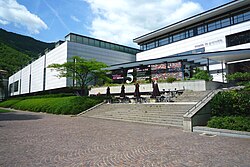Grenoble Museum
 |
|
| Established | 1798 |
|---|---|
| Location | 5 place Lavalette 38000 Grenoble |
| Type | Art museum, |
| Visitors | 176,457 (2012) |
| Curator | Guy Tosatto |
| Public transit access | Tramway B (Notre-dame-Musée), and bus line 32 |
| Website | official website |
Coordinates: 45°11′40″N 5°43′57″E / 45.1945°N 5.7324°E The Museum of Grenoble (French: Musée de Grenoble) is a municipal museum of Fine Arts and antiquities in the city of Grenoble in the Isère region of France.
Located on the left bank of the Isère River, place Lavalette, it is known both for its collections of ancient art for its collections of modern and contemporary art.
The Museum of Grenoble was founded on 16 February 1798 by Louis-Joseph Jay, well before other French provincial museums. That day, an order of the local administration detailed the creation of a museum in Grenoble, in which article 10 stipulated that "the citizen Louis-Joseph Jay is appointed curator of this museum."
In May of that year, the Interior Minister canceled the creation of the museum but a provisional authorization was obtained in December, which became final on 3 April 1800. Beginning in 1799, while engaged in collecting works of art of the Isère Region, Jay requested a public subscription to purchase paintings and drawings.
Housed in four halls of the first floor of the former bishopric from its opening on 31 December 1800, the museum had 298 works of art including 177 paintings, 80 drawings or engravings and 45 sculptures placed in the garden. Each hall had a name, the first Hall of Apollo, was devoted to French painters, the second Hall of Castor and Pollux, was devoted to Italian and French schools, the third Salon of Gladiator, had copies of the life of San Bruno by Eustache Lesueur, and the last hall was called Hall of the Venus de Medici, displaying art of the Flemish school. A few months after its opening, the Concordat of 1801 by Napoleon Bonaparte forced the evacuation of the premises of the museum to restore them to their original purpose.
...
Wikipedia
